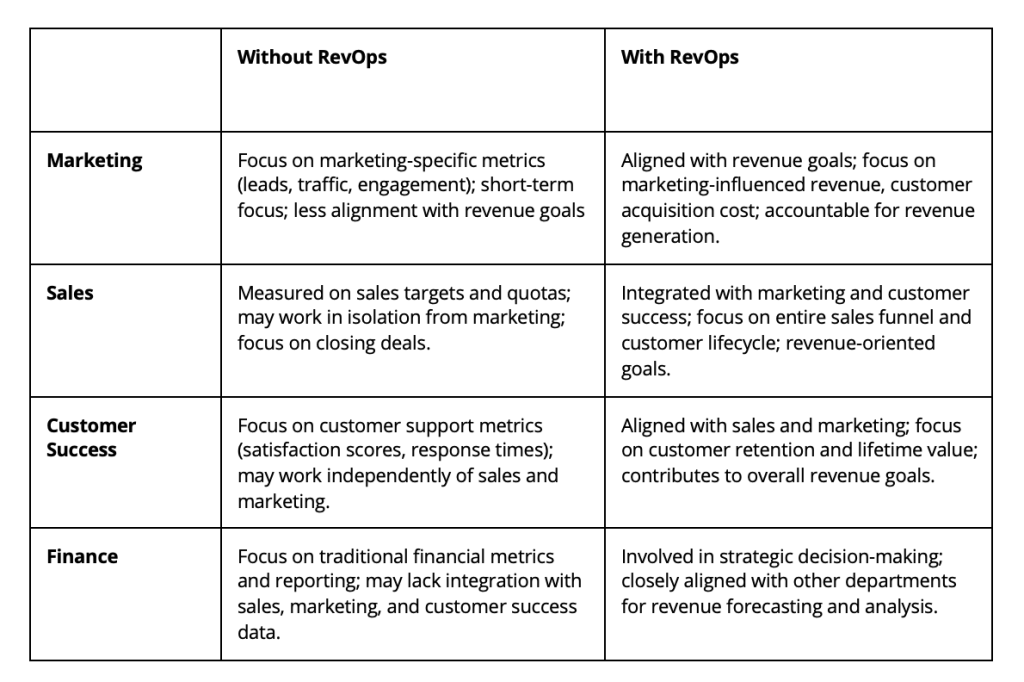RevOps: An Organizational Framework to Maximize Non-Dues Revenue Results

Understanding the importance of revenue across all departments in your association is an important first step. But, having a clear strategy for how to effectively prioritize revenue helps transform the why into the how. One effective strategy for your association could be Revenue Operations (RevOps). In this article, Carrie McIntryre of Navigate explains RevOps and why it might be the solution your association needs to streamline processes, breakdown silos and drive sustainable revenue growth.
Revenue Operations (or RevOps) is a relatively new term that became mainstream in the technology industry in 2017-2018. It breaks down departmental silos between marketing, sales, customer success, and finance to create shared goals for revenue generation and customer satisfaction across the entire customer journey.
Without RevOps
In most organizations, sales, marketing, and customer success (i.e., account management and fulfillment) have goals related to their specific functions. This leads to dysfunction when staff work hard to meet their department’s goals, but in doing so, make it harder for others to meet their department’s goals. Common issues for organizations without a RevOps approach include:
- A marketing team that:
- Believes they’re doing their job because by executing planned campaigns and/or hitting metrics for traffic/activity and lead generation
- Is frustrated there aren’t more testimonials and case studies they can use
- A sales team that:
- Believes they’re doing their job by meeting quotas and/or revenue targets
- Is frustrated they don’t have more qualified prospects
- A customer success team that:
- Believes they’re doing their job by handling customer questions as quickly and pleasantly as possible
- Is frustrated that customers have unrealistic expectations or don’t do their part to be successful
- A management/finance team that:
- Believes they’re doing their job by keeping an eye on revenue progress
- Is frustrated by revenue volatility and a lack of consistent revenue growth
With RevOps
While SalesOps focuses on the sales team and its operations, RevOps looks at the bigger picture to create a more integrated approach that aligns revenue-related functions:

With RevOps, marketing isn’t just about shouting a message from the rooftops – it’s about strategic shouting at the right prospects, like a matchmaker who wants to help you find “the one” vs. a date for this Friday. As a result of more targeted marketing, sales efforts are focused on customers who are the right fit, avoiding unrealistic expectations that lead to poor experiences and churn.
When the right customers are handed off to customer success, fulfillment goes more smoothly, testimonials are easier to come by, leading to more expansions and renewals. The finance team helps these teams collaborate on shared, data-driven revenue goals that everyone monitors, supported by strategic planning for sustainable growth.
A Stronger Culture and Brand
Finally, two of the most rewarding outcomes of a successful RevOps structure are more collaborative and engaged staff members AND customers that become brand champions who actively promote the association for you, creating a powerful growth engine.
RevOps is much more than a business buzzword. It's the framework that keeps different departments working together toward common goals and creating a seamless, efficient, and, let's face it, more enjoyable journey for everyone involved – from your team to your association’s corporate customers.
 Carrie McIntyre
Carrie McIntyre
Navigate
Carrie McIntyre is the founder and principal of Navigate, a sales and customer experience consulting firm that helps associations improve revenue by fixing internal sales operations, empowering staff to enjoy sales, and turning customers into enthusiastic advocates. Her 30-year career began as an association professional in membership and marketing positions followed by sales and customer experience roles with for-profit companies serving associations where she was a consistent top-performer.